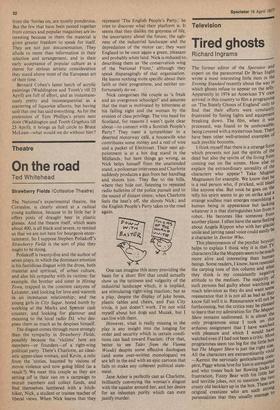Jubilee joke
John McEwen
There is no shortage of humour among artists but few of them express it in their work. Of these few, at least in Britain, Bruce McLean is unrivalled. He is a comedian whose compositions lampoon the pretension and folly around him, both in art and everywhere else. The main thing is that his work is really funny, but in achieving that it has guts and relevance, a liveliness, an interest even, beyond the grasp of almost all his contemporaries. Most of his latest drawings (Robert Self till 21 April) propose an updated design for a Union Jack to go with a new national anthem more appropriate to the spirit of jubilee year. The Tate should book it immediately and exhibit it as their contribution to the jubilee jamboree.
Has there ever been a better joke than that of 1977 being jubilee year? The surreptitious planting of the Union Jack on Rockall has been the only proclamation of our sovereignty to the world in general, and impending destitution has made us so selfpreoccupied that about as many people appear to care whether the Queen has returned from wherever she has been as know whether Denis Howell is still drawing a salary as Minister of Water. Obviously, as Bruce McLean implies, it is no good trying to conjure up the spirit of 1935 in Design Council tat or Arts Council bunting. It is time we faced up to the facts. But if we are to have new insignia then we shall still have a load of designs leading up to them, and drawing up designs, occasionally for other people but usually for themselves, has become another art-form these days. The genre is called the 'working drawing,' ininstantly recognisable by the rulered lines, the pinpricks, the fatuous notes and directions, the grubby sensuality of fingered zips of masking tape and louche dabs of colour, the grandiose titles often acknowledging the great and dead—and the signature, of course. For many the working drawing is a way of life. Here are the titles of some of McLean's: 'Study for the new Union Jack'—based on the new national anthem' "My Way" (Comme d'Habitude) as sung by Frank Sinatra'; 'Political portrait No. 1 '—Harold Wilson behind obscure glass— 'study for a public sculpture (The Large Still) with new British Standard and reeded glass;' Drawing for grey sculpture'—most of the drawing painted out: a common feature of working drawings= "Who's Afraid of Red, White and Blue"; 'Study for sculpture balancing art agents'—the model derived from a Chinese acrobat. It is a bonus if you know about Duchamp and that Barnett Newman painted 'Who's Afraid of Red, Yellow and Blue' but for the rest it is explicit enough. Words are only the half of it.
Compared with McLean's, the drawings and collages of Eduardo Paolozzi (Anthony d'Offay till 22 April) look their age, but that contributes to their fascination. For some time there has been a rather spurious war about who should be called the father of Pop Art, Paolozzi or Hamilton. It is spurious because stylistic categories of this sort bear no scrutiny at all and are largely marketing devices, but if such claims are to be made then Paolozzi's rest firmly on his early collages. The drawings in the present show have been saved from the waste-paper basket and the collages, of various dates from the 'forties on, are mostly ponderous. But the few that have been pasted together from comics and popular magazines are interesting because in them the material is given greater freedom to speak for itself. They are not just documentation. They allude to more than information in their selection and arrangement, and in their early acceptance of popular culture as a theme for serious artistic consideration they stand above most of the European art of their time.
Bernard Cohen's latest batch of acrylic paintings (Waddington and Tooth's till 23 April) are full of effort, and as instantaneously pretty and inconsequential as a scattering of liquorice allsorts, but having said that one has said everything. As for the pretension of Tom Phillips's prints next door (Waddington and Tooth Graphics till 23 April), it brings us full circle to Bruce McLean—what would we do without him ?







































 Previous page
Previous page